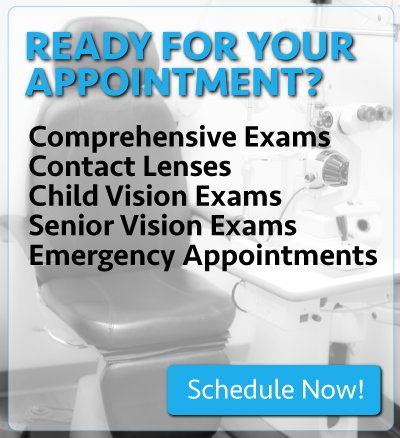The Ontario Association of Optometrists recommends a baby’s first eye exam at six months of age, even if no vision problems are apparent.
Our experienced optometrists screen for any excessive refractive error outside the expected range, eye movement ability, ocular alignment, and any potential eye health problems including retinoblastoma (a rapidly-developing malignant cancer of the eye, almost exclusively found in young children.)
Children Eye Examination for Children Ages 0-19
After the first eye exam, if all findings are normal, children should be seen again at the age of three to ensure normal visual development is continuing. At this exam, binocular and colour vision testing are performed, in addition to tests for refractive errors and overall eye health assessments, to ensure that your child will enter school with optimal visual function and clarity.
Vision Development Milestones:
Parents play an important role in assuring their child’s eyes and vision develop properly. You can help by engaging your children in age-appropriate activities and watching for any signs of potential issues.
The following are some vision development milestones to watch for and foster, though some children reach certain milestones at different ages.
Birth to Four Months:
For the first two months, an infant’s eyes could appear to wander or be crossed. Though lack of eye coordination is normal at this age, if an eye seems to turn in or out constantly, make an appointment right away for an evaluation.
By eight weeks, babies begin focusing on faces and objects within 25 centimeters. Around three months, they begin to track moving objects with their eyes and reach for things with more precision.
Tips to improve eye development during this age:
- Use a nightlight in your baby’s room.
- Change the crib’s position and your child’s position in it frequently.
- Keep toys to reach for about 20-25 centimeters from their face.
Five to Eight Months
Eye movement control and eye-hand coordination skills continue to improve. Depth perception (ability to detect if something is nearer or farther away than other objects,) develops around the fifth month, when eyes work together to form a three-dimensional view. Colour vision also is achieved around this time.
Many babies start to crawl at eight months of age. Crawling greatly helps further development of the visual system, eye-body coordination and fine motor skills.
Tips to improve eye development during this age:
- Hang a mobile above their crib and car seat handle and provide safe objects to hold.
- Make sure they get plenty of “floor time.”.
- Play games like patty-cake, moving their hands through the motions with spoken words.
Nine Months to One Year
By 10 months a baby should be able to grasp objects with thumb and forefinger.
By the time a baby is one year they can judge distances fairly well and throw things with some target accuracy. Many will begin trying to walk. Be sure he or she has had sufficient time crawling for development purposes.
Tips to improve eye development during this age:
- Play hide and seek games with toys to assist developing visual memory.
- Encourage continued crawling.
One to Two Years Old
By two years of age, a child’s eye-hand coordination and depth perception should be well developed. They can recognize familiar objects and scribble with intent.
Tips to improve eye development during this age:
- Roll a ball back and forth to help the child track objects with their eyes.
- Provide building blocks in varying sizes and encourage stacking them to boost fine motor skills and small muscle development.
- Tell stories that stimulate visualization.
Signs of Eye and Vision Problems:
Though infant eye and vision problems are rare, occasionally problems can develop. Keep an eye out for these potential signs (and what they possibly could indicate):
- Excessive tearing – blocked tear ducts
- Red or encrusted eye lids – eye infection
- Constant eye turning – lack of eye muscle control
- Extreme sensitivity to light – elevated pressure in the eye
*OHIP Eligibility is defined by the Ministry of Health and Long-Term Care. Patients aged 20 to 64 years who have any of the following medical conditions can go to their optometrist or physician and receive an OHIP insured eye examination once every 12 months : diabetes mellitus, glaucoma, cataract, retinal disease, amblyopia, visual field defects, corneal disease, strabismus, recurrent uveitis or optic pathway disease.

